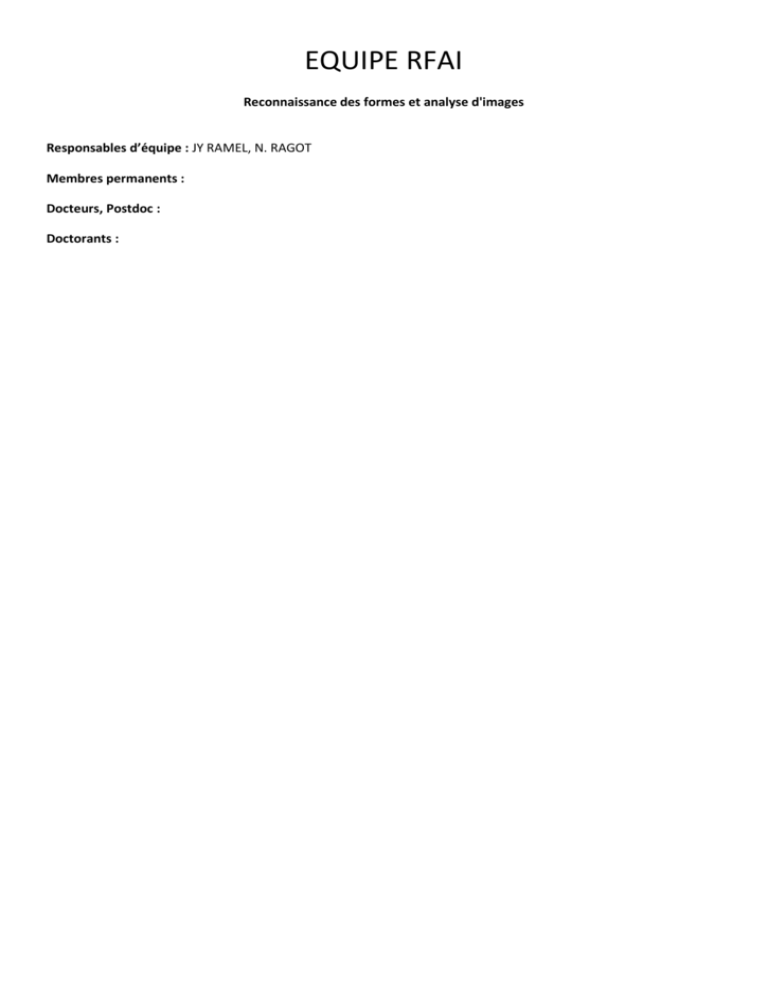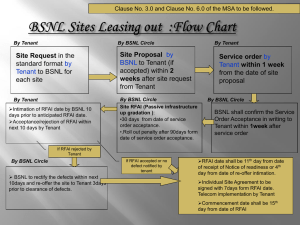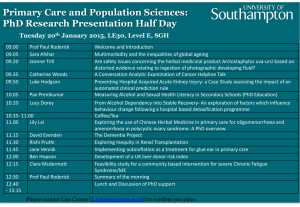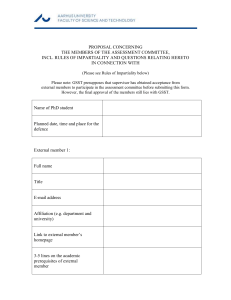Scientific skills and main contributions
advertisement

EQUIPE RFAI Reconnaissance des formes et analyse d'images Responsables d’équipe : JY RAMEL, N. RAGOT Membres permanents : Docteurs, Postdoc : Doctorants : EQUIPE RFAI Reconnaissance des formes et analyse d'images 1. Scientific skills and main contributions The RFAI group is working in pattern recognition and image analysis fields since many years. Along this time, a lot of evolution have occurred and now Pattern recognition is often considered as a high level processing but it is still highly dependent on low level processing to clean, filter and prepare initial data with feature extraction for example. At the same time high level decision and processing could be very useful to help and drive lower level processing. This is why the group has always considered that all the processes in a decision or analyzing system were deeply interdependent, especially considering pattern recognition and image analysis. The strength and the originality of the research works investigated in the team come from the exploitation of these relationships in different manner: The RFAI group highly contributes to the study and development of interactive methods and tools for image and data analysis and classification. To increase more this aspect, the decision of merging with the FOVEA group has been taken just after the last evaluation of the Laboratory (4 years ago). Researchers of this group were and are still working on visual data mining methods and interactive data analysis and visualization algorithms. For this, they are using meta-heuristics, machine learning and graph based methods that are very close and connected with the methods and tools that use for pattern recognition purpose (feature extraction and selection, clustering methods, relevance feedbacks, …) A large number of researchers of the group contribute to the researches on graph based methods for image analysis and structural pattern recognition. Graphs allow to create easily relationships between the low level part (image or data representation) and the high level part (data mining, pattern recognition, clustering, classification,…) of a decision system. As mentioned before, it is one of the scientific goal and, furthermore, graph is becoming a more and more used and studied tool during these last years because of the recent advances in data management, sharing, and proliferation (social networks, heterogeneous and big data, …) Concerning higher level processing and analysis of data streams, the RFAI group has also made significant contributions in a research field that we abusively call “meta-learning”. For us, it corresponds to different works on representation learning (adaptive HMM) and dynamic and incremental learning methods (One class classifiers …) that we have proposed in a recent past. In the image analysis aspect, the expertise of the team comes mainly from the specificities of the data we have to deal with. On one side, original adaptations of image analysis methods initially dedicated to natural images (detection, indexing and matching of keypoints) to be efficient also on binary images (images of digitized documents) have been proposed. On the other side, original frameworks for the segmentation of medical images (2D,3D, 3D+T, videos) have been proposed based on specific features and representations of their contents Interactive methods and tools In this context, we have more specifically worked on: FOVEA User-driven image analysis (Agora, Paulhac, Galisot). Interactive optimization of OCC (Girard, DOD-DIC) Graph based-methods and tools In this context, we have more specifically worked on: Neighborhood graphs for data clustering and visualization (Octavio, Rayar) Explicit Graph embedding techniques able to incorporate topological information (Sidere) and statistical information (Luqman) Optimization of GED methods (Abu-Asheih). Benchmarking of Graph matching methods : GEM (Conte et AL) and GED (Abu-Asheih) Meta-Learning The RFAI group develops general pattern recognition solutions that can be further adapted to the problems it has to deal with. The group is more particularly interested in the elaboration of models and of learning methods based on incremental or dynamic process. In this context, we have more specifically worked on: OCC for incremental learning and interactive classification (Ngoho, Girard) The learning and structure determination of graphical models. Two kinds of graphical models were investigated: Bayesian networks (M. Luqman) and Hidden Markov Models (Ait-Mohand). Optimization of sequence matching and prediction methods to improve the forecast precision (Cherif, Mondal). Meta-heuristics not yet ?? but in the future ???. => du coup peut etre faut il revoir le terme “metalearning” ? Specific Feature and representation methods for nD+T image analysis The works done by the RFAI group are concerning methods and algorithms for characterization and segmentation of 2D and 3D images. A special effort is focused on what is the combination of algorithms, human-computer interaction, using a priori knowledge and information fusion. The town of Tours is a recognized center for the training and research in the areas of Health and Medicine. Several collaborations are currently underway between our team and the University Hospital of Tours. In this context, we have more specifically worked on: Regarding the segmentation of 3D medical images by active surfaces, we have proposed improvements in the incorporation of a priori knowledge in the models (Ahmed). The adaptation of 3D image segmentation methods to textured images has also been studied (Paulhac) Keypoint detection indexing and matching (The Ahn). Graph based representation for images and videos analysis (Conte) 2. Scientific Production The group maintains several indictors about its scientific publications such as statistics about ranked publications into international databases (ISI, Scopus and CORE), both for journals and conferences. Below are the overall publications statistics: Scientific production ACL ACNL ACL + ACLN ACTI ACTN OS et OV 2010 2011 2012 2013 2014 2015 to appear DO PhD HdR Co-auteurs inter-equipe LI Co-auteurs Regional Co-auteurs National Co-auteurs International Prix, best papers, … The overall number of publications has decreased since 2006, but still remains higher than the ones of years 2003-2004. In fact, there was a peak in 2006 corresponding to the end of many PhD in the group. Considering the quality of our publications, lots of conferences in our research field are quite selective (acceptance rate less than 50%) and recognized by the community: publications in these conferences are well considered for the qualification stage of assistant professor. This is why the group published a lot in those ones. Nevertheless, we are aware of the importance to also publish into high-level journals. Consequently, during the last three years, we have reduced our number of publications into conferences (except for recognized ones that are referenced into Core and Scopus) to provide higher efforts to publish into high-level Journals (most of them have impact factor (ISI), or are referenced into the CORE and Scopus databases). These efforts must continue. 3. Projects, collaborations and social impact A. International collaborations and Research projects Much international collaboration are still active: - - - with the Universidade da Beira Interior (Covilhã, Portugal) and the Artificial Intelligence and Computer Science Laboratory (LIACC, Univ. Porto, Portugal). A PhD thesis on the design of a novel biometric system has been carried out (S. Cauchie, ended 12/2009) under the joint supervision of France and Portugal. Our team was responsible for the "pattern recognition" axis while Portugal has lent its expertise in security and cryptography. This has resulted in 4 collaborative publications and the coorganization of 2 international workshops: Information Security'06 and Information Security'07. with the DAG group of the CVC (Computer Vision Center) led by Professor Josep Lladós in Barcelona (Spain) working in the field of indexing and recognition of document images. This collaboration is in two main areas: (1) continuation of Mathieu Delalandre's research work of (former member of the DAG, recruited in team RFAI since September 2009) (2) co-supervision of the M. Luqman's PhD thesis. 3 common publications are yet identified. with the group "Computer Vision and Artificial Intelligence" led by Professor Horst Bunke, Bern (Switzerland) working in the field of recognition of structural forms (graphs). One of our doctoral students (N. Sidere) will conduct a 1 month stay in this team in March 2010. RFAI team participated in the assembly of the European Project TRANSERE (submitted and not accepted in 2008) in response to the call FP7 Capacities Work Program: Infrastructures INFRA-2008-1.1.2.29: developing improved access to historical archives and cultural collections for research purposes. The coordinator was Mary Elizabeth BOUTROUE of IRHT CNRS Paris. B. National collaborations and Research Projects Nationally, the team is currently involved in the project ANR Navidomass (call restrained / 2006-2010). This project is located, as the project PIVOAN, in the field of image indexing of documents. It is the continuation of the ACI Madonne (2003-2006) whose themes were similar but during which the group RFAI had worked primarily with the L3I (La Rochelle) and the LIRIS (Insa Lyon). Navidomass brought together 6 teams of research participants and additional experts in the field of image analysis and pattern recognition: LI Tours L3i La Rochelle, Rouen LITIS, IRISA Rennes 1, LIPADE Paris 5 and LORIA Nancy. ACI Madonne : RFAI = 15K€ - ANR Navidomass : RFAI = 71K€ Number of joint publications: 5 + 3 (LITIS Rouen) - 8 (L3I La Rochelle) – 7 (LIRIS Lyon) Beside the Navidomass ANR project, the group is working with the LITIS lab from Rouen and with the Bibliothèque Nationale de France (BnF) on the elaboration of an OCR evaluation protocol. These works are conducted thanks to the PhD of K. Ait-Mohand who is an associate researcher at the BnF in reply to the BnF call for associate researcher on new technologies n°48 in 2008-2009 (Analyse des résultats de conversion par océrisation des documents imprimés numérisés de la Bibliothèque nationale de France). This project was prolongated for the year 2010. The team also participated in the national project EPEIRES Techno-Vision (2004-2009) supported by the ministries of research and defense. The objective of the proposed EPEIRES is to create an environment for evaluating performance of some of the treatments required to achieve the recognition and location of symbols in the document images incorporating graphic components. This project involves many partners such as the Laboratory LORIA (Nancy), L3i (University of La Rochelle), the LITIS (University of Rouen), Team DAG CCV (Barcelona), the Laboratory ONE (France Telecom R & D) and society Algo'Tech Computers. Technovision EPEIRES: RFAI = 12K€ - Number of joint publications: 2 (CVC) C. Local and Regional Projects Within the IFR 135 (functional imaging), we are actively working on the segmentation applied to 3D ultrasound image of high resolution. Work is underway with a local academic partner to describe images acquired using a new piezoelectric 3D sensor. A thesis proposing the use of new descriptors of 3D textures and co-supervised with the team 5 of INSERM is ending and helps making available to dermatologists of CHRU Tours a software tool that provides 3D segmentation and volume parameters in order to follow more precisely in time the skin lesions. Another collaboration concerns the characterization of cells images. In connection with the INSERM units U921 and U618, we aims at automatically quantify certain parameters of the images in the context of research against cancer. Two kinds of applications are involved: the counting of cells on images obtained by fluorescent light and the measure of the speed of healing by the wound healing technique. This work fits into the project CRIMOCI filed with the "région Centre" in September 2009 and bringing the INSERM units U921, U966, the cancer institute Gustave Roussy (Villejuif) and us. The objective of this project is to provide the community with an automated tool for screening chemical compounds in order to discover anti-metastatic ones. Number of joint publications: 3 (INSERM team 5) + 2 (Unit U921) In another context, the group has piloted the PIVOAN project, finaced by the Région Centre (2007-2009). The aim of this project is to elaborate a digitalization and retrieval system dedicated to old documents of the Renaissance period so that the CESR (Centre d’étude Supérieur de la Renaissance, UMR CNRS) can easily add new digitalized document to the Bibliothèque Virtuelle Humaniste (Virtual Humanistic Libraries). The group BDTLN from the same laboratory has also participated to this project. This collaboration should continue in the context of R4 project (piloted by the BDTLN group) just submitted to the Region Centre. Its goal is to complete the textual indexing system of the BVH-CESR project by a vocal transcription of the documents. APR Region Centre PIVOAN: 50K€ Coordinateur RFAI = 33K€ + CESR = 17K€ Number of joint publications: 3 (CESR) D. Collaborations with industrial Partners All these actions can validate more academic research. RFAI worked closely with four companies including: A strong collaboration with Snecma began in 2007 and resulted in co-financing (with the region Centre) for a PhD thesis since 2008 (C. Rouzière). This work aims at the automatic recognition of numbers engraved on mechanical parts for the aerospace industry. We still have a good partnership with the ATOS Worldline Corporation: the works initiated on biometrics (handwritten signature authentication) went on based on CIFRE PhD collaboration (J. Fortune). Another CIFRE PhD (S. Hocquet) wass made in collaboration with Cap Monétique society in the field of biometrics. The collaboration with the Faiveley society was mainly focused on the video monitoring problems. Some other collaborations were also established with the following companies: Access Solution (Grenoble): Localization of graphical objects in WYSIWYG interfaces - 6 K€ - Eskape (Tours): Contract ANVAR A0312096F on the financing of a transfer technology as part of an electronic document management in intranet environment. The members of the team participate to numerous research projects at a regional, national or international level, as well as participant (P) than as coordinator (C). Project Adapt + IF135 APR Pivoan APR Dermlab3D APR R4, Crimoci ACI Madonne ANR Navidomass Appel à chercheurs de la BnF Technovision Epeires ANR Digidoc ANR Digidoc FP7 INFRA Transere Role of RFAI C C C P P P c/p P P P P Area Regional Régional Regional Régional National National National national National National International Year 2007 2004-2007 2010 2010-2011 2003-2006 2006-2010 2008-2010 2004-2007 2009-2012 2010-2013 2008 Funding rejected RFAI = 33K€ + CESR = 17K€ Rejected Submitted RFAI = 15K€ RFAI = 71K€ not financed RFAI = 12K€ Rejected Submitted Rejected Valconum??? E. Dissemination, Software and valorisation Training Industrial Valorisation Open source software and prototype Databases / Benchmarks A half-day of practical work lesson about using tools developed during paradiit project is scheduled each year since 2012 in the Master “Patrimoine numérique” propose par le CESR de Tours (15 etudiants/an) A training of 2 days has also been done (same software) for researchers (SHS and SPI) from Nantes interested by these tools. SATT Retro software: VizAssist GBR4GED: graph based repository for GED method evaluation (ob IAPR-TC15 web site) F. Vulgarization, social and cultural impact 4. Research animation and Visibility A. At the International level B. At the National level C. At the Local and Regional level Within the IFR 135 (functional imaging), we are actively working on the segmentation applied to 3D ultrasound image of high resolution. Work is underway with a local academic partner to describe images acquired using a new piezoelectric 3D sensor. A thesis proposing the use of new descriptors of 3D textures and co-supervised with the team 5 of INSERM is ending and helps making available to dermatologists of CHRU Tours a software tool that provides 3D segmentation and volume parameters in order to follow more precisely in time the skin lesions. D. Synthesis about research animation Regional RFAI Seminars National International 1 semnar every 3 weeks Presentation in working groups GDR = JY Ramel (2), S Cauchie (1), S Delest (1) General seminars invitation Animation of seminars (manque aussi les assoc) Organisation of conferences CVC(JY Ramel), UBI(T Brouard) ANAGRAM'06, 2 journées GRCE RFIA 2006 à Tours, 241 participants IFR 135 (Imagerie of Fonctionnelle), PPF GIC (Tours, AFRIF, GRCE et ASTI Orléans, Poitiers, la Rochelle et (membre du bureau) Limoges). program TSI, RFIA 2010, CIFED 2010, ICSNC 2006-2010, RFIA 2008... IS2006-2007 Participation to animation associations or working groups Participation committees to Presidence of program committee Invited associated editor Reviewing (Journals) 5. Team composition, management and animation A. Team composition Equipe multisite – forte croissance ! Generally, 7 or 8 PhD students (around 1 per permanent member) are working within the team. Ten obtained their PhD degree between 2006 and 2009. Most of them also succeed in their professional career (lots of them are assistant professor) which seems to indicate they are well prepared. Every year, several master students do their internship within the team. At the level of local involvement, many team members participate on the board of the laboratory and the CSDP (the committee which proposes the selection committees). The team members have also managed the computer research master (5 years) and 3 modules of this master. They represent the laboratory to graduate schools (the former ED SST and the new in creation ED MIPT). They also operate a teaching module of the ED. Recrutement à l’international => MCF Postdoc The RFAI team hosts regularly foreigner PhD students. 4 were welcomed between 2006-2010: 1 from Iran and 3 from Pakistan: 2005-2008: PhD grant of R.J. Qureshi, program of PhD Scholarships for Natural and Basic Sciences France, Higher Education Comission - Pakistan, 2008-2011: PhD grants of M. Luqman and F. Ameed, program of Overseas Scholarship for PhD in Selected Field (Phase-II), Higher Education Comission - Pakistan, We also hosted 3 internship students (2 from India, 1 from Tunisia). Recruitment since 2003 is mostly non-local: PR 2 locals and 2 non-locals, MCF 1 local and 2 non-locals. B. Animation and management The team is managed by a team leader and a co-team leader who are elected for 4 years. A weekly seminar is organized consisting of a scientific presentation, a team meeting and a meeting of permanent. The seminar meets three requirements: - Training of our PhD students to make presentations, ask questions and answer them. It also allows sharing between our diverse areas of expertise and bringing new ideas. - Improving communication between members who are dispersed over many components and sites (IUT, UFR, Polytech'Tours, ENIVL) and taking main decisions. 6. Future works and objectives The RFAI group will persevere to work on its actual domains of expertise with the goal of continuing to be a reference in these domains at the national and international level. Between all the opportunities to achieve this goal, we can mention the following (but not exhaustive): Concerning interactive methods and tools for image and data analysis and classification. To increase more this aspect, the decision of merging with the FOVEA group has been taken just after the last evaluation of the Laboratory (4 years ago). Researchers of this group were and are still working on visual data mining methods and interactive data analysis and visualization algorithms. For this, they are using meta-heuristics, machine learning and graph based methods that are very close and connected with the methods and tools that use for pattern recognition purpose (feature extraction and selection, clustering methods, relevance feedbacks, …) Concerning graph based methods for image analysis and structural pattern recognition. Graphs allow to create easily relationships between the low level part (image or data representation) and the high level part (data mining, pattern recognition, clustering, classification,…) of a decision system. As mentioned before, it is one of the scientific goal and, furthermore, graph is becoming a more and more used and studied tools during this last years because of the recent advances in data management, sharing, and proliferation (social networks, big data, …) Concerning “meta-learning”, similarly as what we have successfully done with FOVEA team, we have also decided to join forces with the members of HANT team and to integrate them (done since September 2015) in our group to take benefic of their expertise in meta_heuristics and to work together on the use of these kind of approaches in the context of interactive and visual data and image analysis, indexation an retrieval tasks





